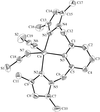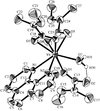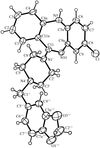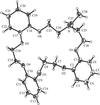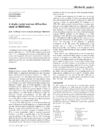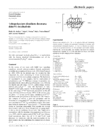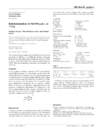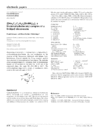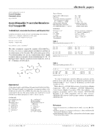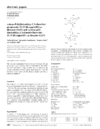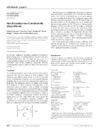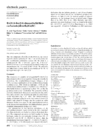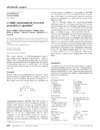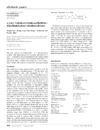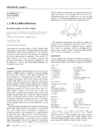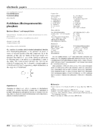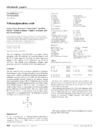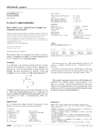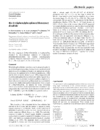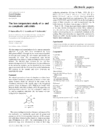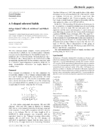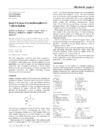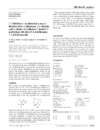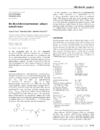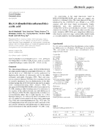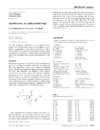issue contents
March 2000 issue

Cover illustration: 25,27:26,28-Bis(3,9-dioxo-6-azaundecane-1,11-dioxy)calix[4]arene tetrahydrate with the water molecules omitted. Displacement ellipsoids are at the 50% probability level. See Kim et al. [Acta Cryst. C56, 379-381].
inorganic compounds
Download citation


Download citation


Linear polymeric edge-sharing CdCl6 octahedra are connected into sheets by bridging CuCl4(H2O)2. Hydrogen bonding completes a three-dimensional network.
Download citation


Download citation


The FeZn13 structure has been redetermined using diffraction data from a single crystal prepared by a flux method. In addition to Zn2 dumb-bells, the monoclinic cell contains Fe-centred Zn12 icosahedra which form infinite chains by vertex-sharing. Chains of icosahedra are linked by octahedra-sharing and by vertex-to-vertex bonding.
Download citation


Download citation


The solid-state compound Sn4.4Mo24O38 is the first reduced molybdenum oxide in which infinite oxygen–molybdenum chains based on two different trans-edge-shared Mo6 octahedral clusters, i.e. dioctahedral Mo10 and trioctahedral Mo14 clusters, are present. The Sn2+ cations statistically occupy channels delimited by the Mo–O chains.
Download citation


Download citation


The title compound, hexaammonium tetra-μ3-selenido-tetrakis(tricyanomolybdenum) hexahydrate, has cyclic hydrogen-bonded [{(NH4)(H2O)}3]3+ cations and [Mo4Se4(CN)12]6− cubane cluster anions. The cation assembly consists of alternating ammonium and water molecules linked by N—H⋯O hydrogen bonds. Cations and anions are linked together by hydrogen bonds involving terminal N atoms of CN groups.
Download citation


Download citation


The new crystal structure of Ba3V2(HPO4)6 consists of a three-dimensional network of vertex-sharing VIIIO6 and HPO4 groups which surround tunnels occupied by 12-coordinated Ba2+ cations.
Download citation


Download citation


In monoclinic β-HBO2, endless zigzag chains are linked via an extensive system of hydrogen bonds with stronger major and weaker minor components. The unique three-dimensional tetrahedral network structure of cubic γ-HBO2 is stabilized by very short asymmetric hydrogen bonds and possesses small empty cages.
metal-organic compounds
Download citation


Download citation


Download citation


Download citation


Download citation


Download citation


Download citation


Download citation


Download citation


Download citation


Download citation


Download citation


Download citation


Download citation


Download citation


Download citation


Download citation


Download citation


Download citation


Download citation


Download citation


Download citation


Download citation


Download citation


Download citation


Download citation


Download citation


Download citation


Download citation


Download citation


Download citation


Download citation


Download citation


Download citation


Download citation


Download citation


Download citation


Download citation


Download citation


Download citation


Download citation


Download citation


organic compounds
Download citation


Download citation


Download citation


Download citation


Download citation


Download citation


Download citation


Download citation


Download citation


Download citation


Download citation


Download citation


Download citation


Download citation


Download citation


Download citation


Download citation


Download citation


Download citation


Download citation


Download citation


Download citation


Download citation


Download citation


Download citation


Download citation


Download citation


Download citation


Download citation


Download citation


Download citation


Download citation


Download citation


Download citation


Download citation


Download citation


Download citation


Download citation


Download citation


Download citation


Download citation


Download citation


Download citation


Download citation


Download citation


Download citation


Download citation


Download citation


Download citation


Download citation


Download citation


Download citation


electronic papers (inorganic compounds)
Download citation


Download citation


The rubidium titanyl arsenate structure has been reinvestigated giving a structural model with well defined oxygen sites and reasonable displacement parameters.
Download citation


Download citation


The title compound was obtained while attempting to produce N-salicylidenetyrosinate oxovanadium complexes at pH ∼ 5 and probably resulted from the slow oxidation of VIVO2+ by atmospheric oxygen. Several decavanadate salts have been obtained under similar conditions.
Download citation


Download citation


The structure of hexaamminenickel(II) dichloride, originally determined at room temperature, has been redetermined at 173 K. There are no significant differences between these structures.
electronic papers (metal-organic compounds)
Download citation


Download citation


The title compound, bis(tetrahydroborato)[1,1,2,2-tetramethyl-1,2-ethylenebis(η5-cyclopentadienyl)]zirconium, was obtained from the reaction of the zirconocene dichloride with lithium tetrahydroborate. The molecule adopts an approximate C2v symmetry. Both tetrahydroborate ligands are η2-coordinated and tilted by 18–19° out of the equatorial plane.
Download citation


Download citation


The title complex shows a square-planar coordination and has an inversion centre at the Cu atom. The carboxylate group of the N-acetylanthranilate ion acts as a monodentate donor ligand to copper and as an acceptor of an intramolecular hydrogen bond from the coordinated water molecule.
Download citation


Download citation


The two title compounds are isomorphous. The binuclear CuII units have a cage structure and are linked by dioxane molecules to form a zigzag chain along the c axis. The binuclear copper unit and the dioxane ligand each has an inversion centre.
Download citation


Download citation


In the title compound, the Tb atom of the trianionic cation lies on a site of  crystallographic symmetry and the unique Tb—O distance is 2.278 (2) Å. One of the perchlorate anions has threefold crystallographic symmetry, while the other is disordered about a
crystallographic symmetry and the unique Tb—O distance is 2.278 (2) Å. One of the perchlorate anions has threefold crystallographic symmetry, while the other is disordered about a  site.
site.
Download citation


Download citation


The title compound has crystallographic mirror symmetry and the coordination polyhedron around the Sn atom is a tetrahedron [C—Sn—C 139.3 (2)° and S—Sn—S 82.3 (1)°] distorted towards a skew-trapezoidal bipyramid owing to an intramolecular Sn⋯S contact [3.0427 (6) Å]. The molecules are linked into a linear chain by intermolecular O—H⋯O hydrogen bonds [O⋯O 2.646 (3) Å].
Download citation


Download citation


The Sn atom in the title compound is five-coordinate and has a trans-C3SnO2 trigonal-bipyramidal geometry arising from bridging through the O atom of the ureido fragment of an adjacent carboxylate group. Infinite chains propagate helically along the c axis and adjacent chains are linked by N—H⋯O hydrogen bonds into layers.
Download citation


Download citation


The crystal structure analysis of the substituted ferrocene complex 2-[2-(4-bromophenyl)-4-cyano-5-ferrocenylpyrazolo[2,3-a]pyridin-7-yl]acetonitrile shows that the pyrazolopyridine ring system, the bromophenyl ring and the cyclopentadiene ring are nearly planar.
electronic papers (organic compounds)
Download citation


Download citation


Two centrosymmetrically related donors in the title charge-transfer complex form a face-to-face π-dimer with a strong intermolecular S⋯S interaction, and the π-dimers stack to form a donor column. The structure is extensively hydrogen bonded.
Download citation


Download citation


In the title compound, a luminescent fluorene dimer, the substituent chains lie on one side of the molecule. Ring planes of neighbouring molecules are approximately perpendicular so that there is no π-stacking.
Download citation


Download citation


In the reaction of pyridine dithiomonometaphosphoryl fluoride with ethyldiphenylphospine, the title compound was formed as a by-product due to traces of water in the system.
Download citation


Download citation


In comparison with the known orthorhombic polymorph of the title compound, the crystal structure of the monoclinic polymorph reported here is more closely packed.
Download citation


Download citation


The crystal structure of the indole alkaloid caulerpin, previously reported in space group Cc, has been redetermined in the correct space group, C2/c. The molecule has twofold crystallographic symmetry and is composed of two essentially planar indole groups fused to an eight-membered cyclooctatetraene ring which adopts a boat conformation.
Download citation


Download citation


The title compound has crystallographic threefold symmetry, with the P—O bond along the threefold axis. Main dimensions include P—O 1.488 (4), P—C 1.823 (3) Å and O—P—C 114.7 (1)°.
Download citation


Download citation


In the title compound, the crystal packing shows that the molecules are linked by N—H⋯O and O—H⋯O hydrogen bonds.
Download citation


Download citation


The title compound, obtained by electrochemical oxidation of 2-(diphenylphosphino)benzenethiol, has twofold crystallographic symmetry. Principal dimensions include S—S 2.0212 (15) Å, S—C 1.786 (3) Å and C—S—S—C 81.34 (14)°.
Download citation


Download citation


Although the two enantiomers crystallize in different space groups, the cell volumes, densities and the packing of the racemic and chiral structures are essentially the same. The main difference in the molecular stuctures can be described by the torsion angles associated with the H atoms of the methyl substituents.
Download citation


Download citation


3-Iodo-2-phenyl-3H-3-selenaindazole has an almost planar conformation and a nearly ideal T-shape for the Se(INC) moiety [Se—I 2.8122 (12), Se—C 1.881 (7) and Se—N2 2.051 (6) Å; C—Se—N 79.6 (3), C—Se—I 96.8 (2) and N—Se—I 176.17 (17)°]. This arrangement, together with the two selenium lone pairs, leads to a distorted trigonal-bipyrimidal geometry about the Se atom.
Download citation


Download citation


The π-conjugated molecule of the title compound is almost planar. Molecules in the crystal are packed in stacks with antiparallel molecular orientation and slightly alternating distances [3.37 (7) and 3.41 (8) Å] between mean molecular planes.
Download citation


Download citation


The structures of a 2-oxa-5-thiabicyclo[4.1.0]heptane derivative, (I>), and a 2H,3H,5H-1,4-dithiepine derivative, (II>), are reported. The six-membered ring in (I) has an envelope conformation and the seven-membered ring in (II>) adopts a chair conformation.
Download citation


Download citation


In the asymmetric unit of the title compound, 2C12H24N+·C6H8O42−·H2O, the carboxylate anion lies about an inversion center, the water molecule is on a twofold axis and the sec-ammonium cation is in a general position. Cations link the oxygen ends of two adjacent carboxylate anions to form an eight-membered ring. The ion pair propagates as a linear chain and adjacent chains are linked through the water molecules into layers.
Download citation


Download citation


The title compound exists in the solid state as a centrosymmetric hydrogen-bonded dimer [O⋯O 2.661 (3) Å].
Download citation


Download citation


The title compound is an antibacterial drug. The molecule, which crystallizes as a trihydrate, is in the zwitterionic form in the solid state. Hydrogen bonds stabilize the molecules in the lattice.


 journal menu
journal menu




























